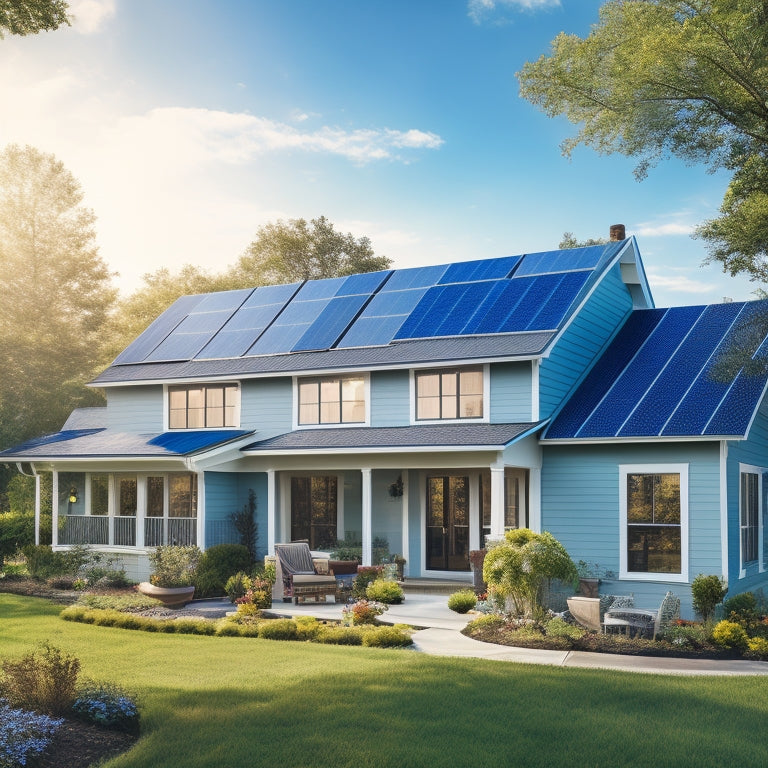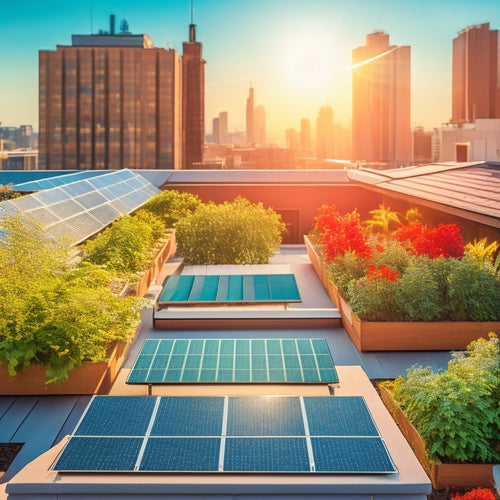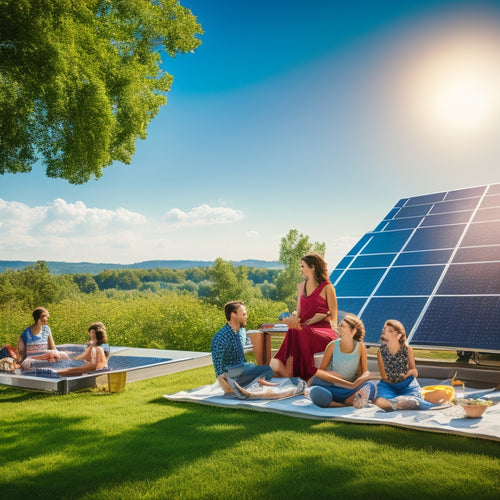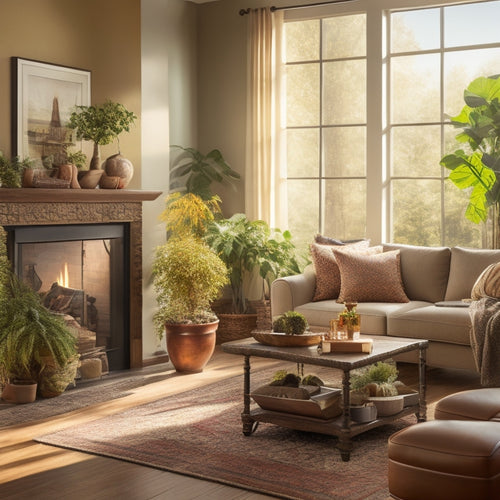
How Many Solar Panels Are Required for an Average Home?
Share
You'll need a solar panel system capable of producing between 15 and 30 kilowatts of power per day to meet the energy demands of an average home, depending on various factors that will influence the final number of panels required. Your specific energy needs will depend on your daily energy consumption, which you can determine by tracking your usage over a month and identifying opportunities for reduction. Other factors, such as roof size and orientation, shading, and panel efficiency, will also impact the number of panels you need. As you investigate these factors, you'll get a clearer illustration of the ideal system size for your home.
Key Takeaways
- Average daily energy consumption in kWh determines the required solar panel system size, which can be calculated from past utility bills.
- Roof size, orientation, and shading affect the number of panels needed, with south-facing roofs being optimal for energy production.
- Panel efficiency ratings influence the number of panels required, with higher efficiency ratings reducing the number of panels needed.
- Energy storage solutions, local building codes, and regulations must be considered when determining the ideal system size for an average home.
- A thorough assessment of energy consumption patterns, roof space, and local factors is necessary to estimate the ideal system size and number of solar panels required.
Calculating Your Energy Needs
Your daily energy consumption is the starting point for determining how many solar panels you'll need for your average home. To calculate this, you'll need to evaluate your lifestyle habits and the amount of energy you use daily.
Start by tracking your energy consumption over a month to get an accurate illustration. Look at your past utility bills to determine your average daily energy usage in kilowatt-hours (kWh).
Next, identify areas where you can reduce your energy consumption. Are there opportunities to switch to energy-efficient appliances or turn off lights and electronics when not in use? Making these changes can lower your overall energy needs and reduce the number of solar panels required.
Reflect on your energy-intensive habits, such as running a home office or powering a hot tub. These habits will impact the size of your solar panel system.
Factors Affecting Panel Requirements
Now that you've calculated your daily energy needs, it's time to evaluate the factors that will affect the number of solar panels required to meet those needs.
The type of solar panel you choose will greatly impact the overall system size. For instance, high-efficiency panels may require fewer units, while lower-efficiency ones may need more.
Installation costs also vary depending on the complexity of the job, local labor rates, and permits required. Your energy consumption patterns will influence the system's overall capacity, as will local regulations governing renewable energy installations.
Shading effects from trees, buildings, or other obstructions can reduce energy output, necessitating more panels to compensate. The orientation of your roof will also impact energy production, with south-facing installations typically being the most effective.
Maintenance requirements, such as cleaning and repair, should be factored into your overall system design. Finally, inverter options will affect the system's performance, with string inverters being a popular choice for residential installations.
Determining Roof Size and Space
Across the roof, available space is a critical component in determining the number of solar panels you can install. To accurately assess your roof's potential, you'll need to evaluate its size, orientation, and any obstacles that might impact energy production.
Start by measuring your roof's length, width, and total square footage. You'll also need to determine your roof's orientation, which can greatly impact energy output. A south-facing roof is ideal, but east- and west-facing roofs can also be suitable.
Next, perform a shading analysis to identify any areas that receive partial or full shade throughout the day. This can include trees, chimneys, vents, or neighboring buildings. Shading can reduce energy production, so it's critical to factor these areas into your calculations.
Understanding Panel Efficiency Ratings
Having assessed your roof's size, orientation, and shading, you can move on to evaluating the solar panels themselves. This involves understanding panel efficiency ratings, a vital factor in determining how many panels you'll need.
Panel efficiency refers to the percentage of sunlight converted into electricity. Higher efficiency ratings mean more power per panel, which can reduce the overall number of panels required.
When comparing panel efficiency, you'll encounter different panel technologies, each with its strengths and weaknesses. Monocrystalline silicon panels, for instance, offer high efficiency ratings (up to 22%) but are more expensive.
Polycrystalline silicon panels, on the other hand, have lower efficiency ratings (around 15-18%) but are more affordable. Thin-film panels are another option, with lower efficiency ratings (around 7-14%) but a more competitive price point.
When making an efficiency comparison, consider your energy goals and budget. If you have limited roof space, high-efficiency panels might be the better choice.
However, if you're on a tighter budget, lower-efficiency panels could still provide significant energy savings. By understanding panel efficiency ratings, you can make an informed decision about the best panel technology for your needs.
Estimating the Ideal System Size
With your energy objectives and panel effectiveness in mind, you're prepared to estimate the ideal system size for your average home. This involves evaluating several factors that affect your solar panel system's performance.
To determine the ideal system size, you'll need to take into account the following:
-
System orientation: The direction and angle of your solar panels can greatly influence energy production. Best orientation varies by location, but generally, a south-facing roof with a tilt between 30° to 40° is ideal.
-
Roof size and space: Assess the available roof space to determine how many panels can fit. Confirm you have enough space for the required number of panels.
-
Energy storage: If you want to store excess energy generated during the day for use at night or during power outages, you'll need to factor in energy storage solutions, such as batteries.
- Local building codes and regulations: Familiarize yourself with local building codes, permits, and regulations that may impact system size and installation.
Frequently Asked Questions
Can I Install Solar Panels on a Shaded Roof?
You can install solar panels on a shaded roof, but it'll decrease their efficiency. Shading can reduce energy output by up to 20%, so you'll need more panels to compensate, increasing overall cost and complexity of the installation.
Do Solar Panels Work During Power Outages?
As you imagine yourself shielded from the dark, you're wondering: do solar panels work during power outages? Unfortunately, they don't, unless you have a backup system, like a battery, to grant you grid independence, ensuring your lights stay on when the rest of the world goes dark.
How Often Should I Clean My Solar Panels?
You should prioritize solar panel maintenance by cleaning them every 6-12 months, as dirt and debris can reduce energy output by up to 25%; regular cleaning guarantees peak performance and maximizes your power generation.
Can I Expand My Solar Panel System Later?
As you scale your energy ambitions, you'll find that upgrading your inverter and adding energy storage can seamlessly integrate new panels, allowing you to expand your solar panel system later, like building blocks snapping into place.
Are Solar Panels Resistant to Extreme Weather?
You'll find that solar panels are designed to withstand extreme weather conditions, boasting impressive durability and performance in harsh environments, so you can rest assured they'll keep generating power even in the face of intense storms or scorching heat.
Conclusion
You've finally got the scoop on what it takes to power your humble abode with solar energy. And let's be real, it's not a small feat - we're talking hundreds of panels blanketing your roof like a shining armor of sustainability. Okay, maybe not hundreds, but you get the idea. The point is, going solar requires some serious calculation and consideration. So, take a deep breath, crunch those numbers, and get ready to bask in the radiant glow of renewable energy!
Related Posts
-

Solar System Installation Rebates and Tax Credits
Solar system installations offer beneficial rebates and tax credits that greatly cut your initial costs. You can bene...
-

Solar Power Savings for Environmentally Aware Consumers
Switching to solar power lets you drastically cut your carbon footprint while saving money in the long run. Each kilo...
-

How to Reduce Home Energy Bills
To reduce your home energy bills, start by investing in energy-efficient appliances and upgrading your insulation. Lo...


